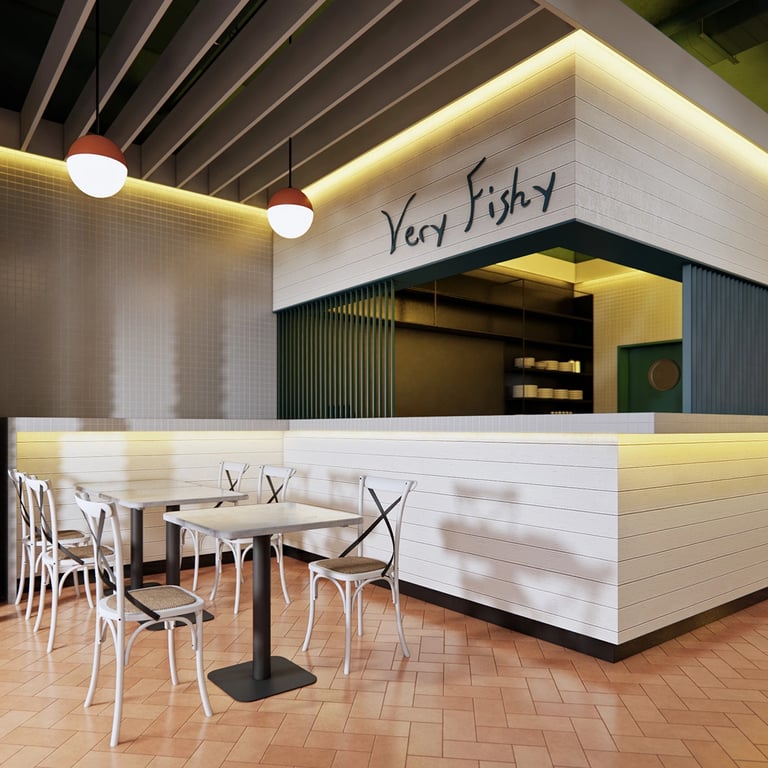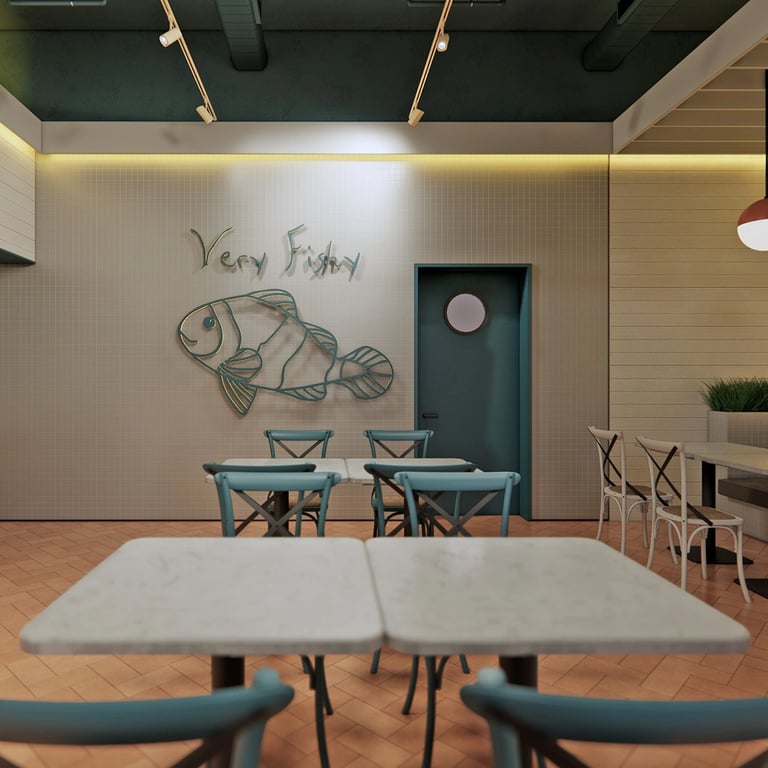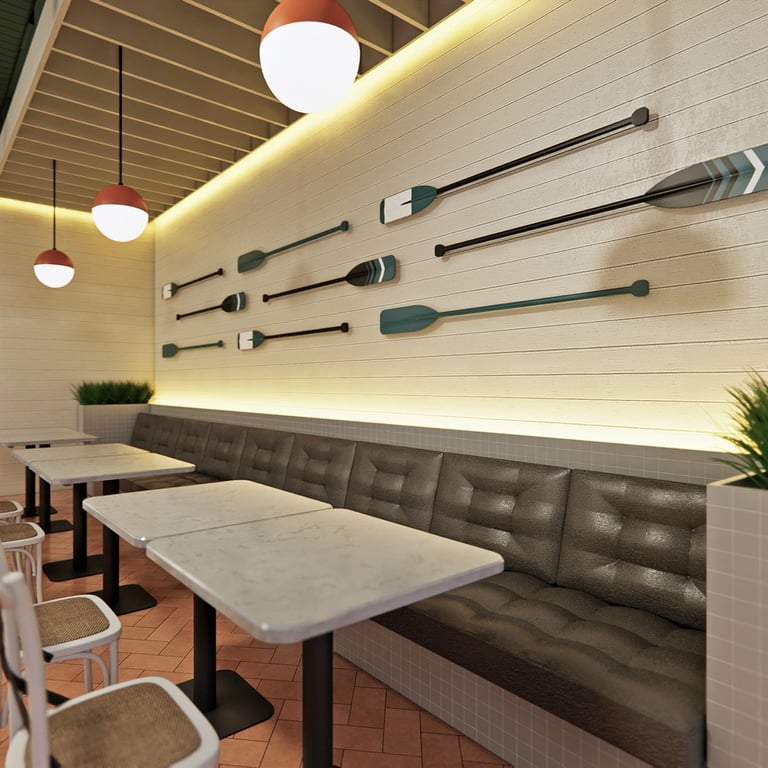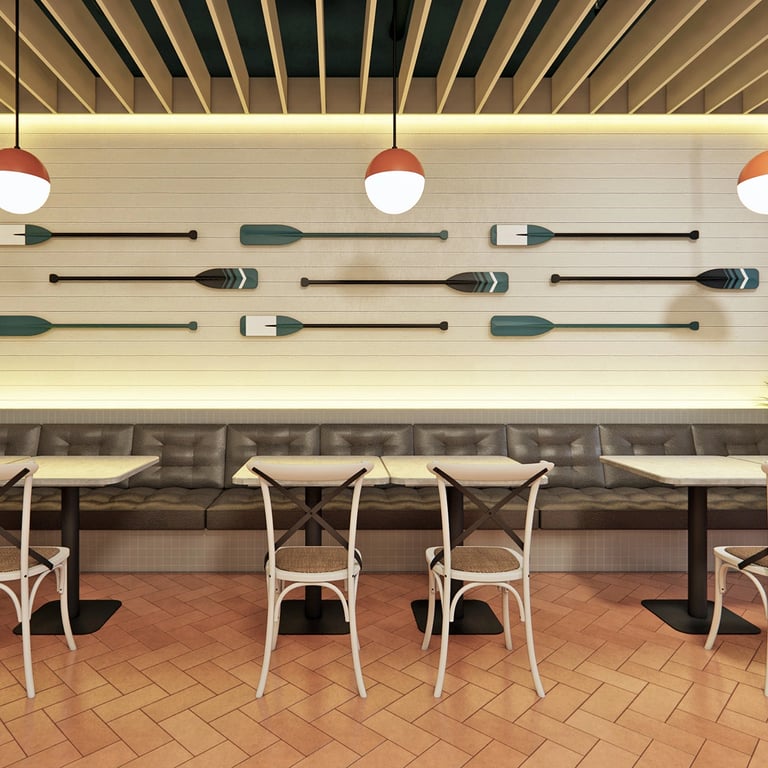



Very Fishy: A Masterpiece of Mediterranean-Inspired Seafood Restaurant Design in Sydney’s Manly Wharf
Introduction: A Coastal Culinary Haven in Sydney’s Iconic Waterfront
In the bustling yet serene Manly Wharf, Very Fishy emerges as a pinnacle of seafood restaurant design, blending Mediterranean simplicity with nautical sophistication. Designed by KENURO archietcts, this project redefines waterfront dining through biophilic design principles, sustainable materials, and an immersive maritime aesthetic.
Drawing inspiration from Sydney’s maritime heritage and the rustic charm of Mediterranean fishing villages, Very Fishy is more than a restaurant—it’s a sensory journey where every detail, from the rope-wrapped light fixtures to the pebble-textured flooring, evokes the ocean’s timeless allure.
Why Manly Wharf? The Perfect Setting for a Seafood Restaurant
Manly Wharf is one of Sydney’s most sought-after waterfront destinations, known for its laid-back coastal vibe, stunning harbor views, and vibrant dining scene. The suburb’s pedestrian-friendly promenade, ferry access, and proximity to Sydney’s CBD make it an ideal location for Very Fishy, ensuring high foot traffic and visibility.
Concept & Vision: A Nautical Narrative Woven into Design
The architectural vision for Very Fishy was to create a space that feels organic, timeless, and deeply connected to the sea. Unlike generic seafood restaurants, this project avoids clichés, opting instead for refined textures, handcrafted details, and an open, airy layout that maximizes natural light and waterfront views.
The Importance of Brand Creation in Restaurant Design
A strong brand identity is crucial for standing out in a competitive market. Very Fishy achieves this through:
A cohesive color palette of ocean blues, sandy neutrals, and brass accents
Custom typography and signage that reinforces the maritime theme
A unique dining experience that tells a story, from decor to menu presentation
Why Good Design Matters for Restaurants
Enhances customer experience – Thoughtful layouts and aesthetics keep diners engaged.
Boosts profitability – Well-designed spaces encourage longer stays and repeat visits.
Strengthens brand recall – Memorable interiors make your restaurant shareable on social media.
Choosing the Right Architects for Your Restaurant
Not all architects specialize in hospitality design. When selecting a firm, consider:
Experience in restaurant projects – Look for portfolios with similar concepts.
Understanding of workflow – A well-designed kitchen and service areas improve efficiency.
Sustainability focus – Eco-friendly materials and energy-efficient layouts reduce long-term costs.
New Trends in Restaurant Design for 2024
The best restaurant designs today incorporate:
✔ Biophilic elements – Natural wood, greenery, and water features create a calming atmosphere.
✔ Flexible seating – Modular furniture adapts to different group sizes and events.
✔ Tech-integrated dining – QR menus, ambient lighting control, and sound zoning enhance guest comfort.
✔ Sustainable practices – From upcycled decor to zero-waste kitchens, eco-consciousness is key.
What Restaurant Owners Should Consider When Opening a New Venue
If you're planning a new restaurant, keep these factors in mind:
Location & Demographics – Does the area attract your target audience?
Concept & Uniqueness – What makes your restaurant different?
Operational Flow – Are the kitchen, bar, and dining areas efficiently arranged?
Material Durability – Can surfaces withstand high traffic and spills?
Lighting & Acoustics – Balanced brightness and sound levels improve guest comfort.
Inspiration from Global Coastal Design Trends
Similar to Rockpool Bar & Grill (Sydney) by Eskew+Dumez+Ripple and The Boathouse (Palm Beach) by Luchetti Krelle, Very Fishy embraces raw, organic materials while maintaining a polished, contemporary edge.
Key influences include:
Ibizan beach clubs – Whitewashed walls, woven textures, and open terraces.
Greek tavernas – Communal seating, rustic wood, and blue accents.
Sydney’s historic wharves – Industrial elements softened by maritime décor.
Interior Design Breakdown: A Deep Dive into Every Space
1. The Entrance: A First Impression That Captivates
The entryway sets the tone with:
A reclaimed timber door with brass porthole details
A hand-painted "Very Fishy" sign in distressed blue
Hanging glass buoys and rope-wrapped railings
This design approach mirrors The Grounds of Alexandria’s use of artisanal signage and tactile materials to create an inviting arrival experience.
2. The Main Dining Hall: Where Rustic Meets Refined
The dining area features:
Communal tables crafted from repurposed boat wood
Woven rattan chairs for breathability and comfort
Wall art made from vintage oars and fishing nets
The layout encourages social dining, much like Chiswick at the Gallery (Sydney) by ACME, where long tables foster a convivial atmosphere.
3. The Bar: A Striking Maritime Focal Point
The bar is a sculptural masterpiece, featuring:
A countertop embedded with seashells and crushed mother-of-pearl
Backlit aqua-blue glass shelves resembling ocean waves
Brass porthole mirrors and rope detailing
This echoes Icebergs Dining Room & Bar (Bondi) by Layan Design Group, where translucent materials and reflective surfaces mimic water.
4. The Terrace: Alfresco Dining at Its Finest
The outdoor space includes:
Whitewashed pergolas with billowing linen drapes
Built-in banquettes with navy-blue Sunbrella cushions
Potted olive trees and herb gardens
Similar to The Dolphin Hotel (Surry Hills) by George Livissianis, the terrace blurs indoor-outdoor boundaries, making it ideal for Sydney’s temperate climate.
Material Palette: Sustainability & Sensory Appeal
Natural & Locally Sourced Materials
Reclaimed timber (from decommissioned boats)
Hand-glazed terracotta tiles (inspired by Mediterranean courtyards)
Brushed brass fixtures (for a subtle nautical shimmer)
Eco-Conscious Design Choices
Low-VOC paints for better air quality
Energy-efficient LED lighting with dimmable controls
Upcycled fishing crates as wine storage
This aligns with global restaurant design trends, as seen in Noma (Copenhagen) by Bjarke Ingels Group, where sustainability is seamlessly integrated into luxury.
Conclusion: A Benchmark in Seafood Restaurant Design
Very Fishy is not just a restaurant—it’s a case study in how architecture can elevate dining. By merging Mediterranean warmth, nautical storytelling, and sustainable innovation, this project sets a new standard for waterfront venues in Sydney.
Visit Very Fishy at Manly Wharf – Where Design Meets the Sea.
Designing your future
where innovation meets style, and every space tells your unique story. We blend modern aesthetics with functional design to create spaces that inspire and elevate everyday living.
KENURO architects
KENURO PTY LTD
ABN 22 687 742 132
© 2025. All rights reserved.

Cammeraygal Land
Suite 55 (Level5), 106 High Street, North Sydney, NSW 2060
(T) (02) 8880 0448
KENURO architects acknowledge the Traditional Custodians of country throughout Australia and their connections to land, sea and community. We pay our respect to their Elders past and present and extend that respect to all Aboriginal and Torres Strait Islander peoples today.
